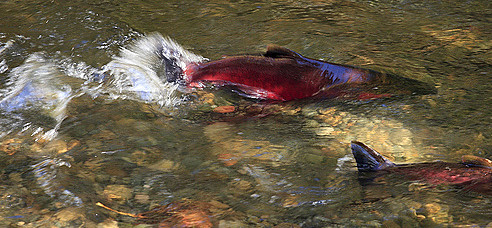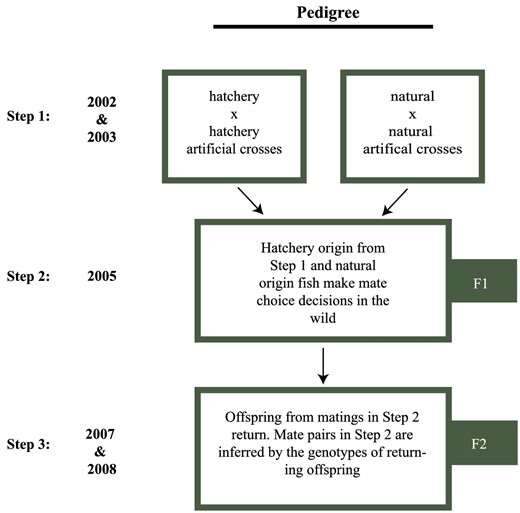feelin swell
Member
A good read for anyone interested in what's going on out there:
2018 study looks at 4 decades of data and discusses leading hypothesized causes of salmon age-size changes. Have a look at what it has to say about the possibility that the increased number killer whales may have something to do with it over the past 40 years.
Also read how the age-size reduction may also have a compounding effect on the overall health of runs. In other words having the largest fish return to rivers instead of smaller ones may be very important. It appears to be an overlooked and poorly understood factor that may be critical to run survival.
https://onlinelibrary.wiley.com/doi/full/10.1111/faf.12272
4.3 Potential causes of observed changes
The reported changes in the size and age distribution of Chinook salmon populations across the Northeast Pacific could be responses to a variety of factors. Commonly hypothesized causes of change in salmon age‐size structure include (i) size‐selective harvest, (ii) environmental change such as changes in temperature regimes or ocean productivity that affect growth and mortality rates, and (iii) impacts of hatchery practices and increased competition for food (including non‐Chinook hatchery populations). A previously overlooked hypothesis attributes the observed changes to (iv) predation by marine mammals, especially a growing number of resident killer whales and their size‐selective predation on Chinook salmon (Chasco, Kaplan, Thomas, Acevedo‐Gutiérrez, Noren, Ford, & Marshall, 2017; Chasco, Kaplan, Thomas, Acevedo‐Gutiérrez, Noren, Ford, & Shelton, 2017). In the following, we present these hypotheses in detail and discuss their qualitative consistency with the findings reported in this paper. A summary of data relevant for evaluating these hypotheses at a broad geographic scale is provided in Figure 8.
4.3.5 Natural mortality
"Resident killer whales, on the other hand, selectively prey upon Chinook salmon, particularly the oldest and largest individuals (Ford et al., 1998; Hanson et al., 2010; Herman et al., 2005). About 90% of Chinook salmon eaten by residents are 4–6 years old (Ford & Ellis, 2006), and the abundance of resident killer whales has continuously increased since the 1970s (Matkin, Ward Testa, Ellis, & Saulitis, 2014; Ward et al., 2016). Currently, the total number of resident killer whales in the Northeast Pacific Ocean is estimated to be at least 2300 individuals (Muto et al., 2017), with many populations increasing 2–3× over the last 40 years.......
Bioenergetics calculations suggest that the residents currently inhabiting the coastal waters between northern California and southern Alaska (not including those along the Aleutian Islands and in the Bering Sea) consumed roughly 104 metric tons of Chinook salmon in 2015, which is ~70% of the total marine mammal consumption by weight (Chasco, Kaplan, Thomas, Acevedo‐Gutiérrez, Noren, Ford, & Shelton, 2017). This is equivalent to an annual consumption of about 2.3 million adult‐sized Chinook salmon, and similar to the recent annual commercial catch in the North Pacific Ocean (~2 million Chinook salmon, Irvine et al., 2009). While the relative contributions of harvest and natural predation vary by population and region, total coast‐wide mortality of Chinook salmon has increased over time despite reductions in fishery harvest. Chinook salmon are exposed to predation by resident killer whales along the coast, and exposure to predation during ocean residence depends on population‐specific ocean distributions and migration patterns (Larson et al., 2013; Weitkamp, 2010). Predation intensity is likely highest for coastal populations from Washington, British Columbia and south‐eastern Alaska, somewhat uncertain for populations in western Alaska, and lowest for populations that do not exhibit the long coastal migrations such as those from California and southern Oregon, as well as some Puget Sound populations. This spatial pattern of exposure to predation is generally coherent with the observed patterns in the declining size of older Chinook salmon across the Pacific coast (Figures 7 and S4) and warrants more examination of the potential of increased predation for contributing to the changing demographic characteristics we have documented in this study.
2018 study looks at 4 decades of data and discusses leading hypothesized causes of salmon age-size changes. Have a look at what it has to say about the possibility that the increased number killer whales may have something to do with it over the past 40 years.
Also read how the age-size reduction may also have a compounding effect on the overall health of runs. In other words having the largest fish return to rivers instead of smaller ones may be very important. It appears to be an overlooked and poorly understood factor that may be critical to run survival.
https://onlinelibrary.wiley.com/doi/full/10.1111/faf.12272
4.3 Potential causes of observed changes
The reported changes in the size and age distribution of Chinook salmon populations across the Northeast Pacific could be responses to a variety of factors. Commonly hypothesized causes of change in salmon age‐size structure include (i) size‐selective harvest, (ii) environmental change such as changes in temperature regimes or ocean productivity that affect growth and mortality rates, and (iii) impacts of hatchery practices and increased competition for food (including non‐Chinook hatchery populations). A previously overlooked hypothesis attributes the observed changes to (iv) predation by marine mammals, especially a growing number of resident killer whales and their size‐selective predation on Chinook salmon (Chasco, Kaplan, Thomas, Acevedo‐Gutiérrez, Noren, Ford, & Marshall, 2017; Chasco, Kaplan, Thomas, Acevedo‐Gutiérrez, Noren, Ford, & Shelton, 2017). In the following, we present these hypotheses in detail and discuss their qualitative consistency with the findings reported in this paper. A summary of data relevant for evaluating these hypotheses at a broad geographic scale is provided in Figure 8.
4.3.5 Natural mortality
"Resident killer whales, on the other hand, selectively prey upon Chinook salmon, particularly the oldest and largest individuals (Ford et al., 1998; Hanson et al., 2010; Herman et al., 2005). About 90% of Chinook salmon eaten by residents are 4–6 years old (Ford & Ellis, 2006), and the abundance of resident killer whales has continuously increased since the 1970s (Matkin, Ward Testa, Ellis, & Saulitis, 2014; Ward et al., 2016). Currently, the total number of resident killer whales in the Northeast Pacific Ocean is estimated to be at least 2300 individuals (Muto et al., 2017), with many populations increasing 2–3× over the last 40 years.......
Bioenergetics calculations suggest that the residents currently inhabiting the coastal waters between northern California and southern Alaska (not including those along the Aleutian Islands and in the Bering Sea) consumed roughly 104 metric tons of Chinook salmon in 2015, which is ~70% of the total marine mammal consumption by weight (Chasco, Kaplan, Thomas, Acevedo‐Gutiérrez, Noren, Ford, & Shelton, 2017). This is equivalent to an annual consumption of about 2.3 million adult‐sized Chinook salmon, and similar to the recent annual commercial catch in the North Pacific Ocean (~2 million Chinook salmon, Irvine et al., 2009). While the relative contributions of harvest and natural predation vary by population and region, total coast‐wide mortality of Chinook salmon has increased over time despite reductions in fishery harvest. Chinook salmon are exposed to predation by resident killer whales along the coast, and exposure to predation during ocean residence depends on population‐specific ocean distributions and migration patterns (Larson et al., 2013; Weitkamp, 2010). Predation intensity is likely highest for coastal populations from Washington, British Columbia and south‐eastern Alaska, somewhat uncertain for populations in western Alaska, and lowest for populations that do not exhibit the long coastal migrations such as those from California and southern Oregon, as well as some Puget Sound populations. This spatial pattern of exposure to predation is generally coherent with the observed patterns in the declining size of older Chinook salmon across the Pacific coast (Figures 7 and S4) and warrants more examination of the potential of increased predation for contributing to the changing demographic characteristics we have documented in this study.



